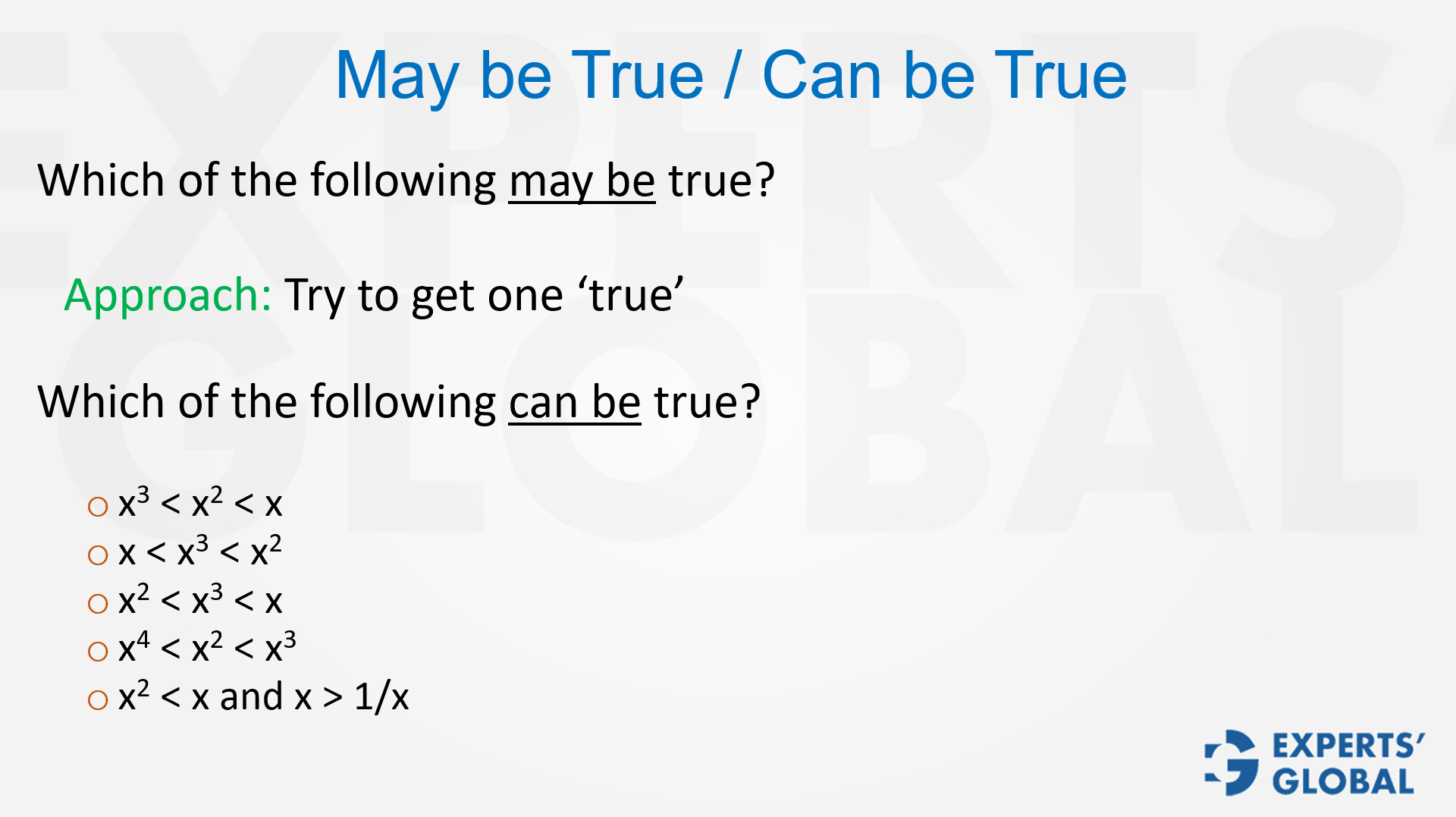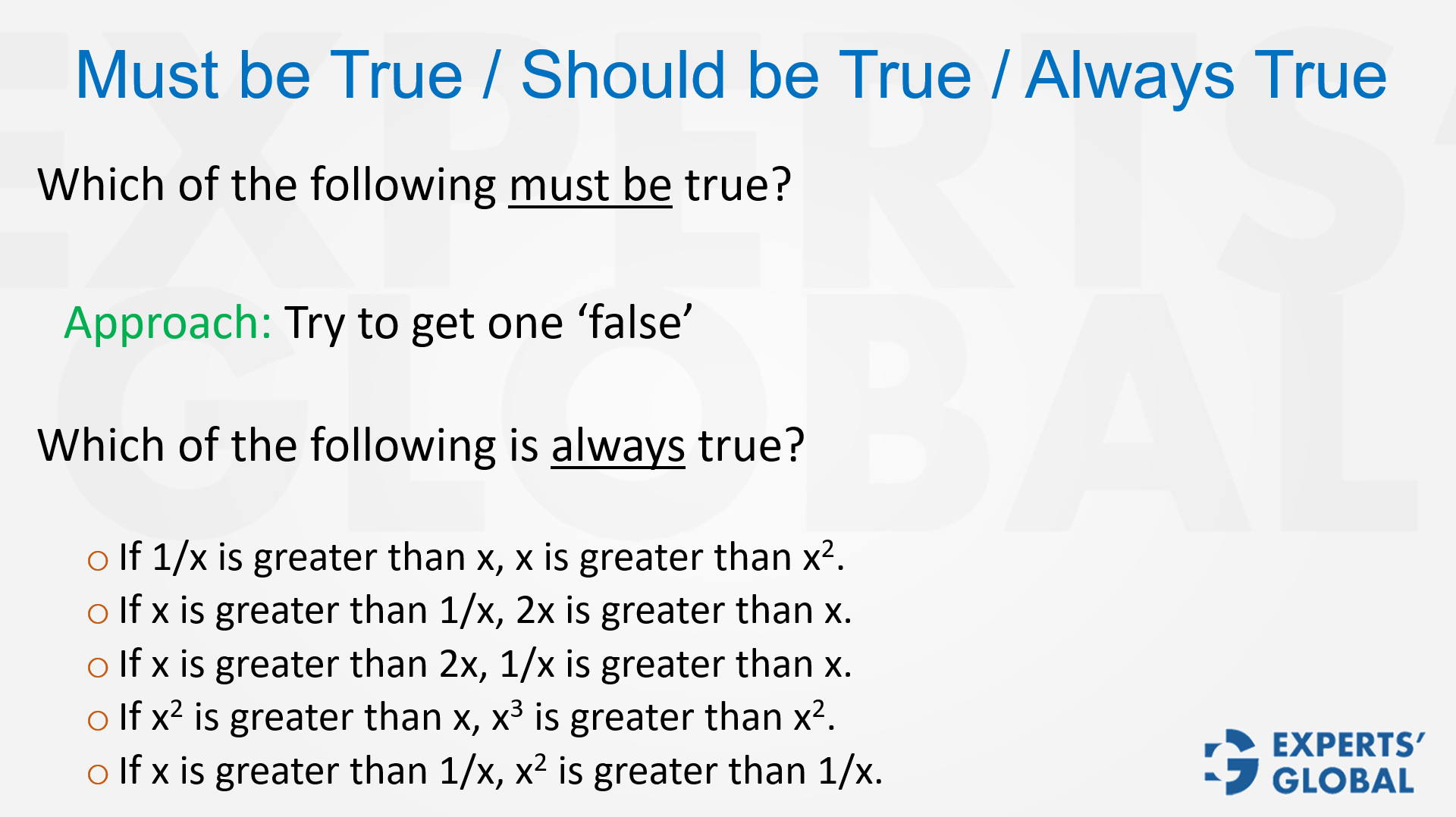Invest 30 seconds...
...for what may lead to a life altering association!
Help Line
- +91.8800.2828.00 (IND)
- 1030-1830 Hrs IST, Mon-Sat
- support@expertsglobal.com
...for what may lead to a life altering association!


On “may be true” or “can be true” questions, a choice is correct if at least one permissible value satisfies the statement; it need not hold always. On “must be true” questions, the statement must hold for all values; one counterexample is enough to eliminate.
For end-to-end MBA application support, explore our MBA admission consulting service
Among the trickiest GMAT questions are those framed as “may be true,” “can be true,” or “must be true.” These are not about solving equations in the usual way but about testing conditions logically and knowing whether a statement works in even a single case or whether it always holds without exception. In may be true or can be true questions, your task is not to prove universal truth but to find just one example where the statement holds. If even one case works, the option is valid. In contrast, must be true or always true questions demand the opposite: if you can find even a single case where the statement fails, you must reject that choice. This mindset – of focusing on one working case or one failing case – is essential in thorough GMAT prep for mastering inequalities.

The GMAT often challenges students with subtle logic-based questions involving phrases like “may be true,” “can be true,” or “must be true.” Success here requires a disciplined approach that balances examples with elimination. On “may be true” (or “can be true”) a choice is correct if at least one permissible value makes the statement hold; it does not need to work always. On “must be true,” the statement must hold for all allowed values; a single counterexample eliminates it. Build the constraints from the stem clearly, list ranges or simple test numbers, and check boundary cases (0, 1, -1, negatives, fractions).
Thumb rule: if you find one working case, mark “may be true”; if you find one failure, rule out “must be true.”
When asked which statement may be true, your goal is to find just one value of x for which the condition holds. Even if the condition fails for most values, that does not matter. For instance, if the question is:
Which of the following may be true?

The first option says x³ < x2 < x. For x = 0.1, this holds true because 0.1³ = 0.001, which is less than 0.1, and 0.1² = 0.01, which is greater than 0.1. Since one case satisfies the condition, this option must be selected.
If you cannot find even a single working case, eliminate that choice.
If the question instead asks “cannot be true,” then the very statement you failed to satisfy becomes the correct answer.
For “must be true” questions, the strategy reverses. Try to find one value where the condition fails. Even a single counterexample eliminates that option. Only when no counterexample can be found does the statement qualify as always true.

For example, consider option E: If x > 1/x, then x² > 1/x. Testing x = 5 shows the condition holds, and testing x = –0.1 also confirms it. In both cases, no contradiction is found, so the statement is always true.
The essence of these questions lies in disciplined testing. For “may be true,” you need one example that works. For “must be true,” you must ensure no example disproves it. Always test values in different ranges: large positives, small positives (between 0 and 1), small negatives (between –1 and 0), and large negatives. This habit uncovers exceptions and ensures accuracy. Mastering this logical framework gives you control over questions that confuse most test takers. It is not about speed alone but about careful reasoning. Build this clarity step by step through practice using GMAT simulated tests.
| Type of Question | Core Idea | Approach | Example | Decision Rule |
|---|---|---|---|---|
| May Be True / Can Be True | A statement is valid if it works in even one case. It does not need to hold for all values. | Try simple values across ranges (large positive, small positive between 0 and 1, small negative between –1 and 0, large negative). If you find just one working case, accept the option. | If asked: Which of the following can be true? Consider the option x³ < x < x². For x = 0.1, we get 0.001 < 0.1 < 0.01, which holds. Therefore, this choice is valid. | One working case = select. If no working case is found, eliminate. |
| Must Be True / Always True | A statement is valid only if it works in all cases with no exceptions. | Try to disprove the statement by finding even one counterexample. If you succeed, eliminate it. If no counterexample exists, accept it. | If asked: Which of the following must be true? Consider the option If x > 1/x, then x² > 1/x. For x = 5 and x = –0.1, both conditions hold. No | One counterexample = eliminate. If no counterexample exists, select. |
Some truths ask for a single witness; others demand proof that survives every test. That is the lesson of may be true and must be true. In GMAT preparation, explore possibilities with small, clean trials and then challenge them across ranges. In your MBA applications for a target school like ISB, craft claims you can evidence consistently through transcripts, projects, recommendations, and interviews. Let results, not rhetoric, carry the day. In life, run thoughtful experiments while holding a few non-negotiable principles. Curiosity opens doors; integrity decides which doors deserve to stay open. Train both muscles and your decisions become calm and strong.